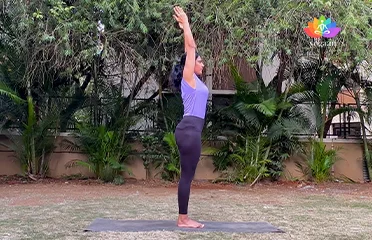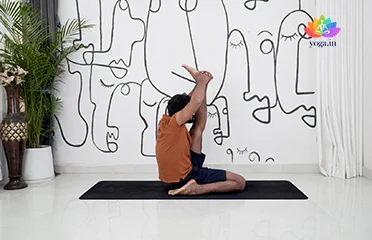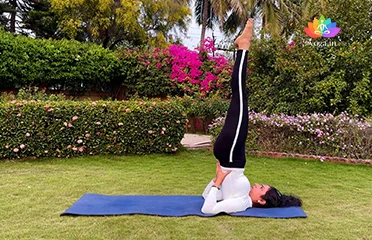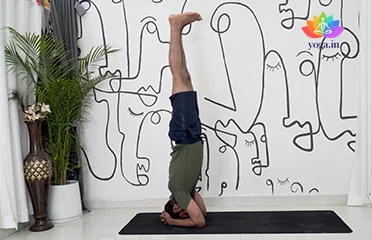Hastapadasana (Hand to Foot Pose)
हस्तपदासन / Hand to Foot Pose
The sanskrit name is derived from hasta (हस्त) means hands, pada (पदा) [�K]
Kraunchasana (Heron Pose)
क्रौञ्चासन / Heron Pose
The Sanskrit name is derived from Kraunch (क्रौञ्च) meaning heron [�K]
Sarvangasana (Shoulderstand)
सर्वाङ्गासनI / Shoulderstand
The Sanskrit name is derived from Sarva (सर्वाङ्ग) meaning all, [�K]
Sirsasana (Headstand)
शीर्षासन / Headstand
The Sanskrit name is derived from Sirsa (शीर्ष) meaning head and asana [�K]
How Yoga Can Help Cure Nasal Catarrh:
Nasal catarrh is the excessive build-up of mucus in the nose and throat, often leading to congestion, discomfort, and breathing difficulties. Yoga can significantly help in managing and alleviating the symptoms of nasal catarrh through specific postures and breathing exercises that promote sinus drainage, enhance respiratory health, and reduce inflammation.
Understanding Nasal Catarrh:
Nasal catarrh, also known simply as catarrh, is a condition where there is excessive mucus production in the nasal passages and throat. This can be triggered by infections, allergies, or other irritants. Catarrh can be acute, with symptoms lasting a few days to weeks, or chronic, persisting for months or even years. It often leads to a blocked or runny nose, a sore throat, and a persistent need to clear the throat.
Yoga’s Role in Relieving Nasal Catarrh:
Specific yoga practices can help alleviate the symptoms of nasal catarrh by clearing nasal passages, reducing inflammation, and boosting the immune system. Gentle asanas (postures), pranayama (breathing exercises), and relaxation techniques can all contribute to better respiratory health and relief from nasal congestion.
Key Factors Contributing to Nasal Catarrh:
Several factors can contribute to the development of nasal catarrh, including:
- Infections: Viral or bacterial infections can lead to increased mucus production.
- Allergies: Allergic reactions to pollen, dust, or pet dander can trigger catarrh.
- Environmental Irritants: Exposure to smoke, pollution, or strong odors.
- Chronic Sinusitis: Persistent inflammation of the sinuses can cause ongoing catarrh.
- Deviated Septum: A structural issue in the nose that can impede airflow and cause mucus build-up.
- Reflux: Acid reflux can irritate the throat and contribute to catarrh.
Symptoms of Nasal Catarrh:
Common symptoms of nasal catarrh include:
- Nasal Congestion: A blocked nose that makes breathing difficult.
- Runny Nose: Excessive mucus production leading to a constantly runny nose.
- Sore Throat: Irritation and soreness in the throat due to mucus drainage.
- Persistent Cough: A cough that is often worse at night, caused by mucus dripping down the throat.
- Facial Pain: Pain or pressure around the sinuses and forehead.
- Reduced Sense of Smell: Difficulty smelling due to nasal blockage.
- Headache: Pain around the forehead and eyes due to sinus pressure.
Treatment of Nasal Catarrh through Yoga and Pranayama:
Yoga and pranayama can be highly effective in managing nasal catarrh. Some beneficial practices include:
Specific Yoga Poses:
- Adho Mukha Svanasana (Downward-Facing Dog): Helps open up the nasal passages and improve breathing.
- Uttanasana (Standing Forward Bend): Promotes sinus drainage and relieves congestion.
Pranayama Exercises:
- Nadi Shodhana (Alternate Nostril Breathing): Clears the nasal passages and balances respiratory functions.
- Kapalabhati (Skull Shining Breath): Helps clear the nasal passages and improve respiratory health.
Diet for Nasal Catarrh:
A balanced diet can help manage nasal catarrh. Recommendations include:
- Hydration: Drink plenty of water to thin mucus and stay hydrated.
- Anti-Inflammatory Foods: Include ginger, turmeric, and green leafy vegetables to reduce inflammation.
- Vitamin C: Consume citrus fruits, berries, and bell peppers to boost the immune system.
- Spicy Foods: Foods with chili or horseradish can help clear nasal passages.
Caution for Nasal Catarrh:
While practicing yoga for nasal catarrh, it is essential to:
- Avoid Overexertion: Practice at a gentle pace to avoid exacerbating symptoms.
- Be Mindful of Breathing: Ensure proper breathing techniques to avoid irritation.
Always consult with a healthcare provider before starting any new exercise regimen, especially if you have severe nasal catarrh or underlying health conditions.
Contraindications for Nasal Catarrh:
Individuals with severe nasal congestion or respiratory issues should:
- Avoid Inversions: Poses like headstands may increase sinus pressure and discomfort.
- Steer Clear of Intense Practices: Vigorous yoga can be overwhelming and counterproductive.
- Seek Professional Guidance: Consult a yoga therapist or healthcare professional for personalized recommendations.





